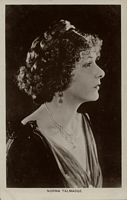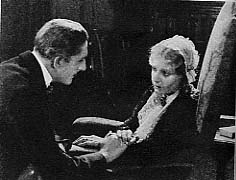

Secrets (1924) Norma Talmadge Productions/First National. Produced by Joseph M. Schenck. Directed by Frank Borzage. Adaptation by Frances Marion. Photographed by Tony Gaudio. Costumes: Clare West. Cast: Norma Talmadge, Eugene O'Brien, Patterson Dial, Emily Fitzroy, Claire McDowell, George Nichols, Harvey Clark, Charles Ogle, Francis Feeney, Alice Day, Winston Miller, May Giraci, Gertrude Astor, Winter Hall, Frank Elliott, George Cowl, Clarissa Selwynne, Florence Wix. 8 or 9 reels. Copies of this film are located at the Museum of Modern Art in New York (16 mm. edited viewing copy with Czech flash titles and 11 reel 35 mm. acetate negative with Czech intertitles), Cinémathèque Royale in Brussels (5889 ft.), Gosfilmofond of Russia in Moscow (unconfirmed) and UCLA (unconfirmed). The Library of Congress has reels 1-3 and 6-9, plus many sections of undetermined reels (35 mm., nitrate elements preserved but restoration on hold pending funding and arrangements with other archives)
| As the middle-aged wife. Thanks to Cleo in Luxembourg for this photo. (click on the thumbnail for a larger view) |  |
Joseph M. Schenck production, starring Norma Talmadge. Adapted by Frances Marion from the play by Rudolph Besier and May Edgington. Directed by Frank Borzage. Shown at the Astor theatre, N.Y., March 24, 1924, for a run. Running time, 91 min.
| 1923 Mary Carlton |
Norma Talmadge |
| John Carlton | Eugene O'Brien |
| Dr. Arbuthnot | Winter Hall |
| Robert Carlton | Frank Elliott |
| John Carlton Jr. | George Cowl |
| Audrey Carlton | Clarissa Selwynne |
| Lady Lessington | Florence Wix |
1865 Mary Marlowe |
Norma Talmadge |
| John Carlton | Eugene O'Brien |
| Susan | Patterson Dial |
| Mrs. Marlowe | Emily Fitzroy |
| Elizabeth Channing | Claire McDowell |
| William Marlowe | George Nichols |
1870 Mary Carlton |
Norma Talmadge |
| John Carlton | Eugene O'Brien |
| Bob | Harvey Clark |
| Dr. McGovern | Charles Ogle |
1888 Mary Carlton |
Norma Talmadge |
| John Carlton | Eugene O'Brien |
| John Carlton, Jr. | Francis Feeney |
| Blanche Carlton | Alice Day |
| Robert Carlton | Winston Miller |
| Audrey Carlton | May Giraci |
| Mrs. Mainwright | Gertrude Astor |
1923 |
(Characters same as in first episode) |
Norma Talmadge is here in the greatest role she has ever been seen in on the screen. As Mary Carlton in "Secrets" she is shown first as a woman past 70, and then, as the action turns back, she is successively in girlhood, young wifehood, a middle-aged mother and then, finally, again as the aged but still loving and beloved wife.
It is a picture that is going to be a tremendous drawing card with women of all ages from the flappers to the grandmothers, and they are all going to love it.
On the screen "Secrets" is a far better entertainment than it was on the spoken stage. Its punches are driven home with greater effect than they were in the spoken play, and the interpretation Miss Talmadge gives of the wife who never wavered, but remained firm in the belief that her husband still loved her best of all, even at the times that she knew he was unfaithful, is something that will go down in film history. It is a work of art, deftly handled with a divine touch that makes it stand out as one of the greatest screen characterizations in years.
In the play the story was told in a straightforward manner, beginning with the early love story and the development of the theme from that point on. In the screen version there is a switch.
Frances Marion, who adapted the play, opens it with several scenes of the modern episode, after which she utilizes the dream idea for the showing of the preceding episodes in the life of the central characters. It is cleverly handled through the medium of the diary of the wife. Thus a lot of footage was avoided and the story runs along entertainingly to hold the interest.
The direction of Frank Borzage must be credited with a great part in the success that the picture is certain to have. He has taken Miss Talmadge and handled her in a manner that makes her reveal artistry such as she never displayed heretofore. Her make-up is a fine piece of work, and at times extends even to her hands. There is one scene for which Borzage must receive untold credit--the one following the siege on the ranch, when victory has perched on the side of the Carltons.
Mary Carlton's husband has gone forth to greet the rescuers, but she turns toward another room where her first-born lies dead. It is such a tremendous change of pace that it stands out like a Rolls-Royce in a showroom full of Cadillacs.
In casting Eugene O'Brien for the lead opposite Miss Talmadge, Joe Schenck made doubly sure of the selling value of the picture. Miss Talmadge and O'Brien as star and leading man built up a screen reputation in a series of pictures five years ago that helped a great deal toward Miss Talmadge's popularity. In "Secrets" O'Brien plays opposite her with the same verve he displayed in the earlier pictures, and the combination of the two is going to be one of the things the fans won't be able to resist.
The balance of the cast is more than adequate; it is splendid. In the second episode of the picture each and every member of the cast, in addition to the two leading players, scores. Patterson Dial as a slavey particularly stands out, while Emily Fitzroy as the mother, Claire McDowell as the aunt and George Nichols as the father are all splendid.
In one of the later episodes Gertrude Astor creates a decided impression.
With all of the telling of the tremendous love tale of Mary and John there is still lots of room for comedy, and not an opportunity has been overlooked to provide a laugh, while in the scene of the western ranch there is enough thrill in the gun fight to satisfy the most rabid wild and woolly fan of pictures.
The sets are colorful and the lightings in the second episode veritable works of art.
There is one question that remains, and that is whether or not this picture is of the required length to furnish a full evening's entertainment in a legitimate house at $1.65 top. It runs only an hour and 34 minutes, and that does not seem to be quite sufficient at that price, no matter how good the picture.
But this much is certain, the picture is going to be one of the biggest box-office knockouts of the year in the regular picture houses.
 |
SECRETS--First National. Married life is made up of secrets--of moments that are hidden away in the silent places of the heart. The poignant secrets of one marriage have been revealed in this picture--with Norma Talmadge as the wife and Eugene O'Brien as the husband. The story is reflected back, across the years, from the pages of a diary--held in the withered hand of a woman who is waiting to hear of her husband's death.
The romance of youth, the elopement. The struggle, as pioneers in a new land. The death of the first baby--during a battle for the lives of all of them! Wealth, at last, and success--bringing, however, the question of the "other woman." Through all of these tense situations we follow and if, at times, the tears are close, we are not ashamed to admit it!
Miss Talmadge does as fine work, in this picture, as she did in "Smilin' Through." In the hoopskirted costume of girlhood she is a delight to the eye, but it is as the pioneer mother, and as the woman of thirty-nine, that she really scores. She rises--upon several occasions--to superb heights. And, though Eugene O'Brien is both good and convincing, he is left behind.
The photography, particularly in the first part of the picture, is touched with real loveliness. And the scenario, by Frances Marion, is always searchingly human. But it is the personality, and the ability of Norma Talmadge that makes this a thing worth seeing. This is a story that should mean much to all married people. And to all people who expect to be married. It teaches a lesson in devotion and tolerance.
Norma Talmadge was never better than when she worked with Frank Borzage. This first of their two collaborations was her greatest critical success, and an outstanding popular one as well. This film could be described as a woman's epic, a somewhat uncommon though not unknown form, structured around an elderly woman recalling the joys and hardships of her married life. In covering the stages of the marriage and the adversities which she has to conquer, each sequence of the film is set in a distinctive style and genre. Their elopement in 1865 is played for quaint comedy, giving 1920s audiences a chance to be amused at the manners of their grandparents. The next sequence is set in the American West, where the frightened wife tries to care for a dying child while their ranch is under siege, taking up arms herself when she realizes that the child is dead. In the third sequence, she is wealthy and middle aged with several children, and tries to retain her dignity when confronted with her husband's mistress and his tearful repentance. Returning to the present, the husband calls to her. The old woman primps a bit and laughs at herself, then goes to him arms outstretched, as the door closes them off in their own world. Borzage's gift for themes of sacrifice and the redemptive power of love was a perfect match for Talmadge's emotional responsiveness, and the film was rapturously received. Reviewers particularly thought it a positive moral influence on audiences and a plea for tolerance (presumably female) in marriage.
Print viewed: 16 mm at The Museum of Modern Art in New York, somewhat worn and scratchy, with Czech flash titles. Note that there is also a print at Gosfilmofond. This print has Russian intertitles and seems to be choppier than the MOMA print. In particular, the scene of the siege of the cabin after the death of the baby is truncated.
Last revised, April 10, 2010